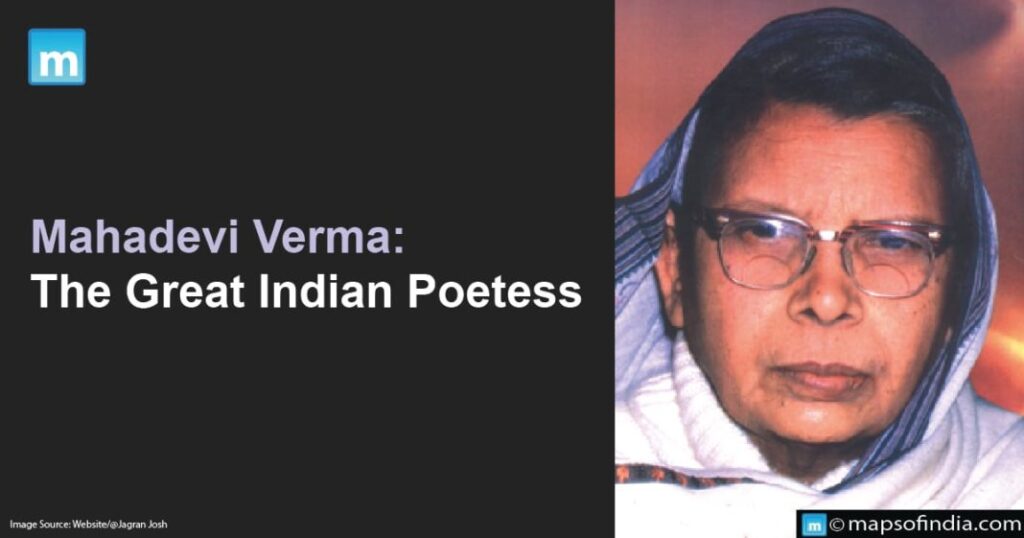“In every science, there is a trace of creativity.“
The most jovial years of our life passed by indulging in the enthralling and creative stories of Mahadevi Verma by befriending the many pets about whom she wrote in her lifetime. We all grew up admiring the grace of Sona, the deer and grieved her loss in the same spirit as the author would have. Guara, Gillu, and Neelu were the household names and tales narrated to every child, familiarizing them with the inspiring figure of Mahadevi Verma. As sanctified and somber as the drapes of white she embraced throughout, the rythms of her poetry are still sung and recited with great pride and cheer. The Modern Meera undeniably left a never dying mark in the heart of people and the world of Indian Literature with the powerful stroke of her ink.
Early Life
Born on March 26, 1907, in Farrukhabad, Uttar Pradesh, India. She hailed from a traditional and conservative family, but her parents, Chaturbhuj Das, and Mukutwati Devi, encouraged her education and nurtured her talent from an early age. Verma displayed a keen interest in poetry and literature during her childhood. She wrote her first verses at seven, reflecting her deep sensitivity and poetic inclination. Despite societal norms that limited educational opportunities for girls, Verma’s parents supported her academic pursuits, and she earned a master’s degree in Sanskrit from Prayag Mahila Vidyapeeth.
During her formative years, Mahadevi Verma was influenced by the nationalist movement in India and the works of renowned poets like Rabindranath Tagore. Her early poems showcased themes of freedom, social equality, and the beauty of nature. Verma’s early life laid the foundation for her illustrious literary career, and her poems continue to inspire and resonate with readers, making her one of the most celebrated poets in Hindi literature.
Literary Contributions
Mahadevi Verma, the acclaimed poetess, played a significant role in the Chhayavaad movement, a romantic and mystical literary movement in Hindi poetry. Her literary works are characterized by their lyrical beauty, introspection, and exploration of women’s experiences and emotions. Verma’s notable works include collections of poetry such as “Yama,” “Muktibodh,” and “Sandhya Geet.” Her poetry often delves into themes of love, nature, spirituality, and the struggles faced by women in a patriarchal society. Her writing style showcased a unique blend of traditional Indian imagery and modern sensibilities.
Achievements
Throughout her illustrious career, Verma received numerous awards and accolades. In 1956, she was honored with the prestigious Sahitya Akademi Award for her poetry collection “Yama.” She was the first woman to receive this honor. Verma was also bestowed with the Padma Bhushan, India’s third-highest civilian award, in 1956 for her literature and social work contributions. In recognition of her immense literary contributions, Verma was nominated as a member of the Rajya Sabha, the upper house of the Indian Parliament, in 1964. She was also appointed as the Chancellor of Mahila Vishwavidyalaya, a women’s university in India. Mahadevi Verma’s literary works continue to inspire and resonate with readers, and her dedication to women’s empowerment and social reform has left an indelible mark on Indian literature and society. Her rich body of work and the recognition she received during her lifetime testify to her lasting legacy.
The essence and particles of the human body withers and fade with dwindling moments; however, the soul navigates the cosmos. Similarly, the grace of artists in the world may be short-lived, but their art lives on like the wings of an immortal bird flapping high and wide through centuries and generations. Such was the profanity of Mahadevi Verma and her literary works, which has and will continue to inspire for generations.
Article Credits: Maps Of India
